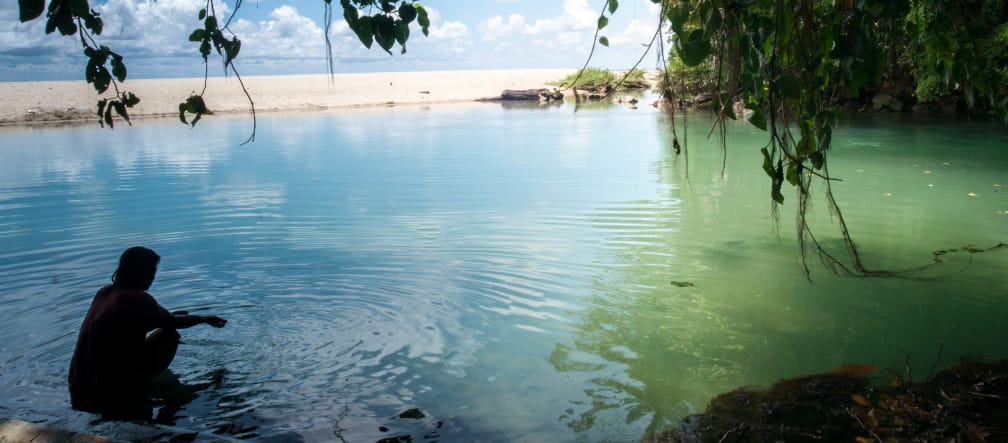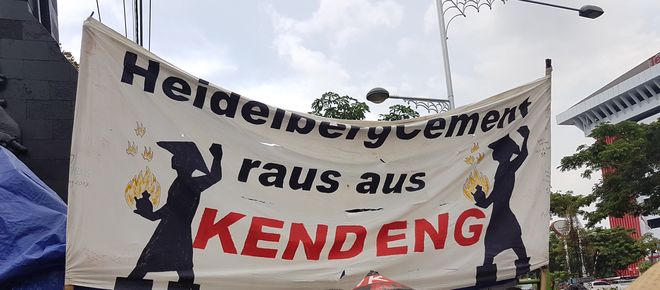
Sulawesi: stop dredging paradise for concrete!
Sand is getting scarce. Around the world, sand from beaches, rivers and oceans is being dredged for concrete and land reclamation projects. In Indonesia, entire coastlines are being eaten way by sand miners, for example in Palu Bay on Sulawesi. JATAM, an anti-mining NGO, is sounding the alarm.
News and updatesTo: Bapak Longki Djanggola, Governor of Central Sulawesi; Bapak Kasman Lassa, Bupati of Donggala
“Stop illegal sand mining in Sulawesi – shut down the sand mines in Palu Bay and Donggala district!”Etal Douw stands at the water’s edge near his hometown of Palu and looks out across the expansive bay. A crater 20 meters deep gapes before him; countless other pits and quarries have shredded this once densely forested coastline.
On the murky Labuan river, one barge after another leaves the scene loaded with sand, leaving behind a lunar landscape. The entire coastline of Palu Bay and into the district of Donggala in Central Sulawesi has been dredged. The Gawalise Hills to the west of the bay are riddled with holes. Mangrove forests are disappearing, rivers are silting up and arable land turning arid.
50 transport ships with a capacity of 3,000 tons each are on the move nonstop, transporting the sand to Borneo. “We have calculated that 18 million tons of sand are being removed from our coast every year – for the Trans-Borneo and Trans-Papua highways, land reclamation and concrete,” explains Etal.
The highways through Borneo and Papua’s rainforests are transport routes for tropical timber, palm oil, ore and other resources. Sand mining is thus not only destroying the Sulawesi coast, it is also helping loggers and miners elsewhere.
According to the United Nations Environment Programme (UNEP), between 47 and 59 billion tons of sand are mined every year, more than half of which is used for cement and concrete production. Cement production has tripled worldwide over the past decade.
For decades, Singapore has been expanding its territory using sand from Indonesia, Cambodia and Myanmar. Dozens of small islands have since disappeared.
“This is having a profound impact on us by ruining our forests, fishing and vegetable cultivation and exposing us to landslides and floods. Sand trafficking is undermining our future!”
Sand – the unknown global crisis
Sand mining is causing a “global environmental crisis that you’ve probably never heard of,” wrote the Guardian in early 2017.
Sand and gravel are being extracted at an unprecedented rate. According to a 2015 estimate by the United Nations Environment Programme (UNEP), 47 to 59 billion tons of sand are mined every year, making sand scarcer than many think. The lion’s share is being consumed by the construction industry to meet exploding demand for cement and concrete. Cement production has tripled worldwide over the past decade. Countries with weak or nonexistent environmental laws, poor human-rights records and rampant corruption such as Cambodia, Myanmar, India and Indonesia are suffering the greatest exploitation. Criminal sand mining gangs operate there with impunity, organized by a mafia with global reach.
Sand is the second most sought-after raw material in the world after water. It is used in the production of glass, electronics, paper and cosmetics. The construction industry uses the lion’s share, however: Sand makes up about two thirds of reinforced concrete. According to UNEP, global concrete production consumed an estimated 25.9 to 29.6 billion tons of sand in 2012. That would be enough concrete to build a wall 27 meters high by 27 meters wide around the equator. 30,000 tons of sand go into one kilometer of an average highway. Sand is increasingly in demand for land reclamation and shoreline development, especially in fast-growing countries like China, Brazil, India and wealthy states like Dubai and Singapore. Desert sand, incidentally, is not suitable for construction and land reclamation due to the poor adhesion of its smooth, round grains. By contrast, sand from oceans and rivers is rough and jagged.
Illegal sand mining in Indonesia
Palu is just one of 16 coastal regions and small islands where sand is mined on a grand scale. There are also hundreds or thousands of other places – from Java to Kalimantan to Sulawesi – blighted by illegal mining. Sand miners wreck coastal ecosystems and leave impoverished local people behind in their wake.
Sand still makes its way to Singapore despite an export ban, but now domestic demand – for harbors, airports, roads and artificial islands – is the main driver.
Sand trafficking is extremely lucrative. Based on data from sand mining for the land reclamation project in Jakarta Bay, our partner organization JATAM estimates the profit from a single shipload of 3,000 tons of sand to be nearly €20,000.
Organized crime is the driving force behind sand mining. The perpetrators are rarely arrested, and those that are generally get away with a slap on the wrist. Journalists and environmental activists are harassed and local people cowed into submission.
Reklamasi – land reclamation from the sea
Dubai and Singapore are prime examples of land reclamation and artificial islands that use sand on a large scale. While Indonesia has since banned sand exports, there is considerable evidence that ships are replacing their flags at sea and supplying Singapore under false pretenses.
Since the ban on sand exports was put in place, numerous Singapore-style land reclamation projects have been proposed quite abruptly in Indonesia. Several major land reclamation projects (Indonesian: reklamasi) have been met with significant resistance. Jakartans have been protesting a giant project involving luxury hotels and palaces in Jakarta Bay for which sand is being stolen from small islands in the west of Java. A further luxury resort is to be built in Benoa Bay on Bali. A luxurious waterfront city, the Center Point of Indonesia, is planned in the south of Sulawesi. A Dutch company, Royal Boskalis, is set to supply the needed sand from the islands of Tanakek and Sanrobone. The authorities are responding to the broad resistance of thousands of families with force. Three protesters are currently in prison.
Sulawesi’s sand mafia
It is not known just how much sand from Palu is currently being shipped to Singapore. Ships carrying sand – crewed by Indonesians who are tight-lipped about the origins of their cargo – are a common sight in Singapore’s harbor.
Numerous illegal sand mining operations exist next to registered ones in Palu Bay and Donggala district. In the port town of Pantoloan, twelve registered companies work side-by-side with a further 38 illegal operations loading material onto their own ships. These 50 companies also occupy long stretches of shoreline for the storage and loading of sand and rock.
Pantoloan’s harbor, designed for goods and passengers, does not have the capacity to handle the sand mining operations. Wherever sand and gravel promise profits, new companies are constantly being established. To set up a port in a convenient location, they simply create an artificial island without permission. The destruction of marine life is an inevitable consequence of dredging and reclamation work. This also means smaller catches for coastal communities that depend heavily on fishing.
An average-size transport ship is capable of carrying 3,000 tons of sand; larger ones can hold up to 6,000 tons. Each of the companies can load and ship 3,000 tons of sand every two to three days. In other words, 18 million tons of sand and stone will be removed from the coasts and mountains of Central Sulawesi in a single year. An impressive figure – one that underscores the rate at which the coast is being dredged up and the profound impact on its natural protective function.
Rock and sand mining on the coast and in the nearby mountains has also left roads badly damaged, and the airborne dust is leading to an increase in respiratory problems among local people.
Neither the province of Central Sulawesi, nor Donggala district or the town of Palu are taking action against illegal sand mining.
To: Bapak Longki Djanggola, Governor of Central Sulawesi; Bapak Kasman Lassa, Bupati of Donggala
Dear Governor Longki Djanggola, dear Mr. Kasman Lassa,
Sand is in great demand for the production of cement and concrete. But now, scientists and the United Nations Environment Programme (UNEP) are warning of the consequences of uncontrolled sand mining. Not only has sand become a scarce resource, illegal mining is causing local and global environmental crises that can no longer be ignored. Much more sand is being mined than the rivers can replace with their sediments. The consequences are ruined coastlines, silted-up rivers and the disappearance of marine life. The coasts lose their protective functions, while local communities are robbed of their livelihoods and exposed to health hazards.
Palu Bay and Donggala district were among Indonesia’s most beautiful and biodiverse areas – before rampant sand mining took hold. It is in your hands to stop the situation from worsening. We urge you to take immediate action against sand trafficking and shut down the illegal mining operations without delay. Environmental and social criteria must be respected in all sand mining operations in Palu Bay and Donggala.
Worldwide public awareness of the issue of sand trafficking is on the increase. Please ensure that the international reputation of your beautiful homeland is not marred by this environmental crime. We urge you to consider the welfare of future generations and preserve the nature of Central Sulawesi, Palu and Donggala for your children and grandchildren. Put an end to sand trafficking!
Yours faithfully,

The renowned Yap Thiam Hien Human Rights Award 2018 will go to the “Friendly Minded” activist community that is resisting the destruction of the Kendeng karst mountains by multinational cement companies, and Eva Bande, who is working to stop mining and oil palm companies on Sulawesi.
The renowned Yap Thiam Hien Human Rights Award 2018 will go to the “Friendly Minded” activist community that is resisting the destruction of the Kendeng karst mountains by multinational cement companies, and Eva Bande, who is working to stop mining and oil palm companies on Sulawesi.